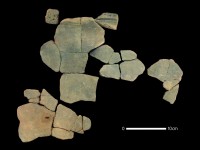![]() The exterior surface of pottery can be a surprisingly rich source of information about ancient flora and fauna. Dents and holes that were once assumed to be insignificant have in the last 25 years been discovered to be impressions left by seeds, nuts or insects. In ancient Japan, for instance, sometimes soybeans and adzuki beans were used in the production of pottery. By examining the cavities they left behind, archaeologists were able to narrow down when cultivation of these staples began in the area.
The exterior surface of pottery can be a surprisingly rich source of information about ancient flora and fauna. Dents and holes that were once assumed to be insignificant have in the last 25 years been discovered to be impressions left by seeds, nuts or insects. In ancient Japan, for instance, sometimes soybeans and adzuki beans were used in the production of pottery. By examining the cavities they left behind, archaeologists were able to narrow down when cultivation of these staples began in the area.
Using X-ray and CT imaging and scanning electron microscopy (SEM), the team of Professor Hiroki Obata at Kumamoto University examined potsherds discovered in the Odake shell mound in Toyama Prefecture which dates to the early Jomon Period of Japan (5,300 – 3,500 B.C.). They found more than 500 Egoma seed cavities on the surface. The team then examined potsherds from the Motonobaru archeological site which dates to the late Jomon Period (2,500 – 1,300 B.C.). They made a silicon replica of the surface which they scanned with a scanning electron microscope. This “impression replica” system allows researchers to examine the original surface in greater detail.
 This time they found the imprints of cockroach egg cases. The cases were 11 mm long and were characteristic of the smokybrown cockroach (Periplaneta fuliginosa) which is from southern China. Historical sources — literary references and artistic depictions — record the presence of the smokybrown cockroach in Japan during the 18th century, but earlier references were thought to be domestic roaches. Since the pottery fragments are 4,000 and 4,300 years old, they indicate smokybrown cockroaches reaches Japan at least 3,700 years before they appear in the historical record.
This time they found the imprints of cockroach egg cases. The cases were 11 mm long and were characteristic of the smokybrown cockroach (Periplaneta fuliginosa) which is from southern China. Historical sources — literary references and artistic depictions — record the presence of the smokybrown cockroach in Japan during the 18th century, but earlier references were thought to be domestic roaches. Since the pottery fragments are 4,000 and 4,300 years old, they indicate smokybrown cockroaches reaches Japan at least 3,700 years before they appear in the historical record.
Pottery fragments from Motonobaru analyzed last year found 173 impressions of the maize weevil. That’s half the total number of ancient maize weevils ever found in Japan.
“The maize weevil is a type of harmful insect that eats stored starch food materials such as acorns or chestnuts, which are known to be typical stored food for that period in Japan. The existence of many maize weevils and cockroaches shows that these ancient humans lived settled lifestyles,” said Professor Obata. “With this latest research, we have revealed that there were cockroaches in human living areas from a period older than was previously believed. More and more information about ancient human life is being found from potsherds. Soft and small items have some difficulty remaining in the soil for a significant amount of time, but they can be kept safe within these pottery fragments. Like little time capsules, potsherds are packed full of treasures which help to reveal the story about the living conditions of ancient humans.”
Indeed, the evil weevil must be from abroad.
Even more so, is ‘Periplaneta fuliginosa‘ possibly a relative of ‘Periplaneta americana‘ ? My assumption, unfortunately, is that those weevils existed before there was ‘Japan’ – and will be around on whatever might be, once Japan is no more.
The existence of a ‘maize weevil‘ also raises the question, where maize originated from, and how it got to Japan. Wherever there is maize, the weevils usually follow soon – unless they feed opportunistic. Even humans are no exception to the rule here.
Not even to mention, where the pottery or silicone might have been brought from. 😮
I wonder if the Chinese pests relate to the arrival of rice cultivation in Japan.
@Toshi Claude Oliver
Cockroaches are not endemic to the Americas. They arrived with European ships. Periplaneta Americana is originally from Africa, so apart from being a coackroach it’s not particularly close to the Asian Periplaneta fuliginosa.
Maise weevils are actually beetles, known as rice weevils in USA. They get into stored grains *such as* wheat, rice, oats, barley, other seeds and starchy foods. There are different species depending on geographical location, but all are believed to have originated in India. So no mystery here. As for how long maize itself has been in the orient, around 400 years or so– among the first items traded by Europeans who settled in the Americas (after they finally figured out how to grow it).